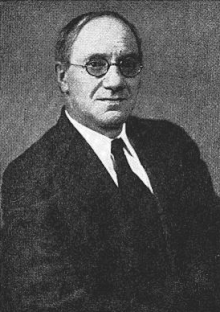Raphael Zon | |
|---|---|
 Raphael Zon | |
| Born | December 1, 1874 Simbirsk, Russia |
| Died | October 27, 1956 (aged 81) |
| Nationality | Russian |
| Citizenship | United States (naturalized) |
| Alma mater | Kazan University; Cornell University |
| Known for | First attempt of a systematic inventory of the earth's forests; first complete map of native vegetation of United States; Technical Director, Prairie States Forestry Project; pioneered studies of the relation of forests to streams and flooding |
| Spouse | Anna Puziriskaya |
| Awards | Gifford Pinchot Medal |
| Scientific career | |
| Fields | Forestry |
| Institutions | United States Forest Service |
Raphael Zon (December 1, 1874 - October 27, 1956) was a prominent U.S. Forest Service researcher.
Early life
Raphael Zon was born in Simbirsk in the Russian Empire in 1874, to parents Gabriel Zon and Eugenia Berliner. A schoolmate of Lenin's, he fled Russia in 1896 while on bail following arrest for organizing a trade union. Zon and companion Anna Puziriskaya, whom he would later marry, fled to Belgium where he studied in Liège.[1] He spent nine months in London before emigrating to the United States in 1898.[2]
Education
Zon's early studies were in Russia. He attended the "classical gymnasium" in Simbirsk, and, studying "medical and natural sciences," graduating from the Kazan Imperial University with a bachelor's degree in "comparative embryology".[3] In the United States, Zon studied forestry under Bernhard Fernow, Filibert Roth and others at the New York State College of Forestry at Cornell University in Ithaca, New York, earning a professional degree of Forest Engineer (F.E.) in the college's first graduating class in 1901.[3]
Career
Upon graduation, he went to work for the U.S. Forest Service, where his career spanned 43 years as a forest researcher. Zon was a protégé' of both Dr. Bernhard Fernow and Gifford Pinchot, first Chief of the United States Forest Service, and a close friend of Bob Marshall in the 1930s.
Zon made significant contributions to forestry literature. Many of his more than 200 scientific publications have been translated into Russian, French, German, and Japanese. With Bernard Fernow, Zon helped establish American forestry’s professional periodical literature. These contributions began when he joined the editorial staff of Forest Quarterly. He deepened his involvement, becoming editor of the Proceedings of the Society of American Foresters in 1905. When Forest Quarterly and Proceedings merged, Zon became one of the founders and the first managing editor of the combined publication, the Journal of Forestry.[4] He served as editor-in-chief of the Journal of Forestry from 1923-28.
Zon was a "giant" among American foresters,[5][6] or as Secretary of Agriculture Claude R. Wickard said, the "dean of all foresters of America."[7]
Commemoration

A large stone memorial with plaque commemorating Zon stands at the USDA Cutfoot Sioux Experimental Forest, in Minnesota, near where his ashes were scattered.[4][8]
Career
- 1901. U.S. Forest Service Student Assistant and assistant to forest investigations in the East
- 1907. Chief, Office of Silvics, later Forest Investigations
- 1920. Special investigations in forest economics
- 1923-1944. Director, Lakes States Forest Experiment Station, St. Paul, Minnesota
- 1923-1928. Director, Cloquet Forest Experiment Station, University of Minnesota
- 1944. Retired, U.S. Forest Service [9]
Accomplishments
- 1908. Proposed the establishment of decentralized U.S. Forest Experiment Stations
- 1914. Charter member, Ecological Society of America[10]
- 1918. National Research Council, Division of Agriculture, Botany, Forestry, Fisheries and Zoology Executive Committee
- 1923-1928. Editor-in-chief, Journal of Forestry
- 1928. International Congress of Soil Science, American vice president of the subcommision of forest soils
- 1930. Charles Lathrop Pack Forest Education Board[11]
- 1940. New York World's Fair "Foreign-born citizens judged to have made the most notable contributions to American democracy in the past 100 years"
- Fellow, Society of American Foresters
- 1952. Gifford Pinchot Medal, Society of American Foresters[12]
- 2005. U.S. Forest Service Centennial Congress Science Leadership Award[13]
- Authored or co-authored roughly 200 articles in professional journals, business and development publications, or popular magazines[3]
References
- ↑ Rudolf, Paul O. (1 January 1957). "R. Zon, Pioneer in Forest Research". Science. 125 (3261): 1283–1284. Bibcode:1957Sci...125.1283R. doi:10.1126/science.125.3261.1283. JSTOR 1753283. PMID 17780698.
- ↑ Pinchot, G., 1945. We present. Journal of Forestry. 43(12):927-928.
- 1 2 3 Schmaltz, Norman J. (1980). "Forest Researcher: Raphael Zon" Part I, Journal of Forest History (January), pp.25-39. Accessed: March 13, 2013.
- 1 2 "FSEEE". FSEEE. Archived from the original on 2012-04-02. Retrieved 2012-12-13.
- ↑ "December 1, 1874: A [Red] Star is Born « Peeling Back the Bark". Forest History Society. 2009-04-20. Retrieved 2012-12-13.
- ↑ http://www.fs.fed.us/rm/pubs/rmrs_p053/rmrs_p053_363_370.pdf
- ↑ Schmaltz, Norman J. 1980. "Forest Researcher: Raphael Zon" Part II, Journal of Forest History (April), pp.86-97. Accessed: March 13, 2013.
- ↑ Adams, Mary Beth; Loughry, Linda; Plaugher, Linda, comps. 2004. Experimental Forests and Ranges of the USDA Forest Service. Gen. Tech. Rep. NE-321. Newtown Square, PA: U.S. Department of Agriculture, Forest Service, Northeastern Research Station. 178 p.
- ↑ "Raphael Zon". Archived from the original on 2008-07-05. Retrieved 2008-01-01. University of North Carolina at Asheville, D.H. Ramsey Library, Special Collections/University Archives
- ↑ "ESA History". Esa.org. 1915-12-28. Retrieved 2012-12-13.
- ↑ Science 7 March 1930: Vol. 71. no. 1836, p. 258
- ↑ Society of American Foresters Pinchot Medal Archived October 10, 2006, at the Wayback Machine
- ↑ "American Trails, National Trails Training Partnership article on Federal Land Management". Americantrails.org. 2007-03-18. Retrieved 2012-12-13.
External links
- "A Red Star is Born." Peeling Back the Bark.
- "The Greatest Good: 100 years," a video on the life and legacy of Raphael Zon, by Char Miller